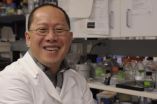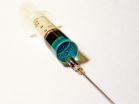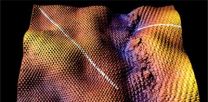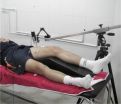(Press-News.org) COLUMBIA, Mo.-- Usually, results from a new study help scientists inch their way toward an answer whether they are battling a health problem or are on the verge of a technological breakthrough. Once in a while, those results give them a giant leap forward. In a preliminary study in a canine model of Duchenne muscular dystrophy (DMD), University of Missouri scientists showed exactly such a leap using gene therapy to treat muscular dystrophy. The results of the study will be published in the journal Molecular Therapy on Jan. 15, 2013.
Muscular dystrophy occurs when damaged muscle tissue is replaced with fibrous, bony or fatty tissue and loses function. Duchenne muscular dystrophy is the most common type of muscular dystrophy predominantly affecting boys. Patients with DMD have a gene mutation that disrupts the production of dystrophin, a protein essential for muscle cell survival and function. Absence of dystrophin starts a chain reaction that eventually leads to muscle cell degeneration and death. For years, scientists have been working to find the key to restoring dystrophin, but they have faced many challenges.
One of the largest hurdles in DMD gene therapy is the large size of the gene. Dystrophin is the largest gene in the human genome, containing approximately 4,000 amino acids. To fit the dystrophin gene into a vehicle that could deliver the gene to the appropriate site in the body, one has to delete 70 percent of the gene. The highly abbreviated gene is known as the "micro-dystrophin" gene. Previous studies suggest that micro-dystrophin can effectively stop muscle disease in mice that are missing dystrophin. However, mice that are missing dystrophin show minimal DMD symptoms, and results from mice often do not predict what will happen in humans. In contrast to mice, loss of dystrophin results in severe muscular dystrophy in dogs. If micro-dystrophin can work in dystrophic dogs, it will likely work in human patients. Unfortunately, when micro-dystrophin was tested in dogs in previous studies, it was not successful.
To overcome these hurdles, a team led by Dongsheng Duan, the Margaret Proctor Mulligan Professor in Medical Research at the MU School of Medicine, engineered a new micro-dystrophin gene that carries an important functional region missing in previously tested micro-dystrophins.
"We placed the new microgene into a virus and then injected the virus into dystrophic dogs' muscles," Duan said. Following gene therapy, Duan's team examined the dogs for signs of muscle disease and measured muscle force in treated and untreated dogs. After careful evaluation of 22 dogs, Duan and colleagues found that the new version of micro-dystrophin not only reduced inflammation and fibrosis, it also effectively improved muscle strength.
"This is the first time that we have seen positive gene therapy results in large mammals of DMD," said Duan. "We still have a lot of work to do, but we now know that our gene therapy strategy works in large mammals; this is a quantum leap forward in fighting this disease. Our next step is to test our strategy in a large group of muscles in the dogs, and then, eventually, see if 'whole body therapy' will work in the dogs. We are still a long way off before we will have a human treatment, but with this finding, I do see a light at the end of this tunnel."
If additional studies, including animal studies, are successful within the next few years, MU officials would request authority from the federal government to begin human drug development (this is commonly referred to as the "investigative new drug" status). After this status has been granted, researchers may conduct human clinical trials with the hope of developing new treatments for Duchenne muscular dystrophy.
INFORMATION:
The study was funded by the National Institutes of Health, Jessey's Journey-The Foundation for Cell and Gene Therapy and the Muscular Dystrophy Association.
-30-
A quantum leap in gene therapy of Duchenne muscular dystrophy
2013-01-15
ELSE PRESS RELEASES FROM THIS DATE:
New path discovered for future generation of glucose-measuring biosensors
2013-01-15
CIC bioGUNE researchers have opened a new pathway for the future development of biosensors that enable measuring the glucose in the blood, but which are also believed to be more reliable with other fluids, such as urine. To this end, a complex scientific process has been developed which has called into question a dominant paradigm amongst the scientific community with respect to the mechanisms of binding and communication between proteins.
The mechanisms of communication at subcellular level are based on the interaction between proteins or between proteins and metabolites ...
Plumber and spray painter high-risk occupations for asthma
2013-01-15
Despite known risks and recommendations for protective equipment, many people are still affected with asthma after exposure to chemicals at work. This is the finding of an international study of 13,000 people carried out at the Sahlgrenska Academy, University of Gothenburg, Sweden.
Asthma is among the most common adult diseases in the world. Despite the fact that the risks of chemical exposure have long been known and that there are well-established recommendations for handling chemicals and protective equipment, many cases of asthma are still caused by exposure to toxic ...
How the protein transport machinery in the chloroplasts of higher plants developed
2013-01-15
Halfway between bacteria and tree
How the protein transport machinery in the chloroplasts of higher plants developed
Moss Physcomitrella patens is an evolutionary intermediate stage
Together with colleagues from Sweden, RUB researchers have studied how the protein transport system of bacteria developed over time to form the system in the chloroplasts of higher plants. They explored the so-called signal recognition particles (SRP) and their receptors. Bioinformatic and biochemical analyses revealed that the moss Physcomitrella patens has evolutionarily old and new components ...
Designer bacteria may lead to better vaccines
2013-01-15
AUSTIN, Texas — Researchers at The University of Texas at Austin have developed a menu of 61 new strains of genetically engineered bacteria that may improve the efficacy of vaccines for diseases such as flu, pertussis, cholera and HPV.
The strains of E. coli, which were described in a paper published this month in the journal PNAS, are part of a new class of biological "adjuvants" that is poised to transform vaccine design. Adjuvants are substances added to vaccines to boost the human immune response.
"For 70 years the only adjuvants being used were aluminum salts," ...
Chemistry resolves toxic concerns about carbon nanotubes
2013-01-15
Safety fears about carbon nanotubes, due to their structural similarity to asbestos, have been alleviated following research showing that reducing their length removes their toxic properties.
In a new study, published today in the journal Angewandte Chemie, evidence is provided that the asbestos-like reactivity and pathogenicity reported for long, pristine nanotubes can be completely alleviated if their surface is modified and their effective length is reduced as a result of chemical treatment.
First atomically described in the 1990s, carbon nanotubes are sheets of ...
Born to lead? Leadership can be an inherited trait, study finds
2013-01-15
Genetic differences are significantly associated with the likelihood that people take on managerial responsibilities, according to new research from UCL (University College London).
The study, published online in Leadership Quarterly, is the first to identify a specific DNA sequence associated with the tendency for individuals to occupy a leadership position. Using a large twin sample, the international research team, which included academics from Harvard, NYU, and the University of California, estimate that a quarter of the observed variation in leadership behaviour ...
Neon lights up exploding stars
2013-01-15
An international team of nuclear astrophysicists has shed new light on the explosive stellar events known as novae.
These dramatic explosions are driven by nuclear processes and make previously unseen stars visible for a short time. The team of scientists measured the nuclear structure of the radioactive neon produced through this process in unprecedented detail.
Their findings, reported in the US journal Physical Review Letters, show there is much less uncertainty in how quickly one of the key nuclear reactions will occur as well as in the final abundance of radioactive ...
New research gives insight into graphene grain boundaries
2013-01-15
Using graphene – either as an alternative to, or most likely as a complementary material with – silicon, offers the promise of much faster future electronics, along with several other advantages over the commonly used semiconductor. However, creating the one-atom thick sheets of carbon known as graphene in a way that could be easily integrated into mass production methods has proven difficult.
When graphene is grown, lattices of the carbon grains are formed randomly, linked together at different angles of orientation in a hexagonal network. However, when those orientations ...
Facebook posts not easily forgotten
2013-01-15
Facebook posts resonate significantly more with human nature than books or even human faces, according to a new study by Laura Mickes and colleagues from the University of California San Diego in the US. The difference in memory between these microblogs and actual published words from a page is as striking as the difference in memory between amnesiacs and healthy controls. The work is published online in Springer's journal Memory & Cognition.
Online social networking is very popular, and allows people to post their thoughts as microblogs, an opportunity that people exploit ...
The muscle response of footballers depends on their position on the field
2013-01-15
Football players display different muscle response parameters depending on the position that they hold on the pitch, according to a study conducted by a team of Spanish researchers which has been published in the 'Journal of electromyography and kinesiology'.
Scientists from the University of Vigo have analysed different muscle response parameters in 78 Spanish first division footballers who have been playing for between four and fifteen years. They found variations depending on the field position of the players.
Published in the 'Journal of Electromyography and Kinesiology', ...



